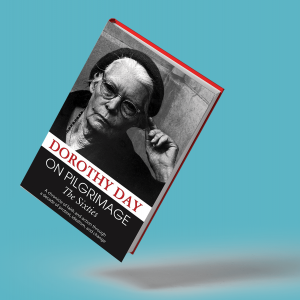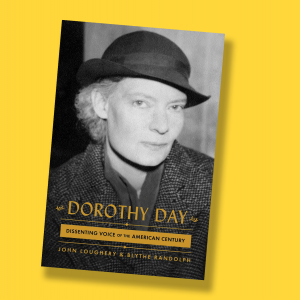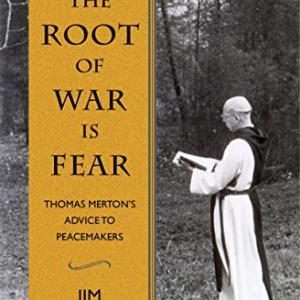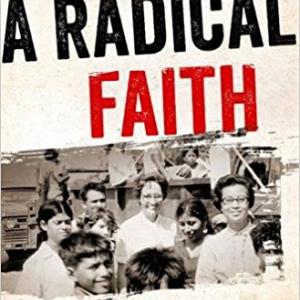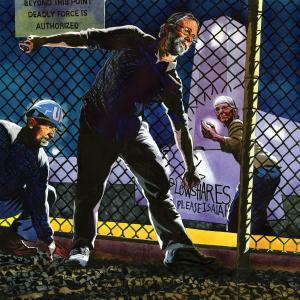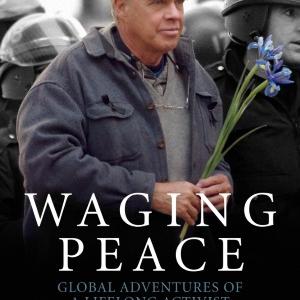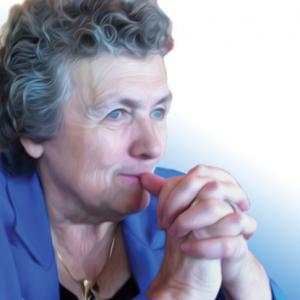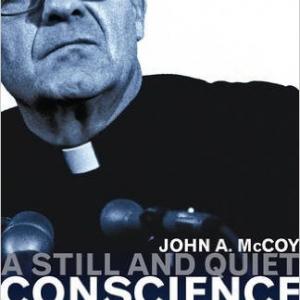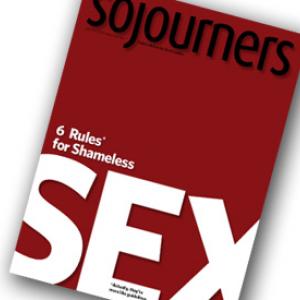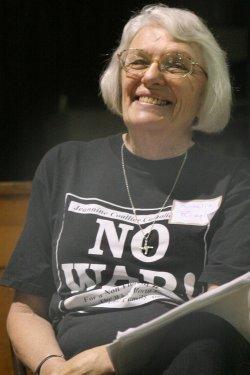
Rosalie G. Riegle is a Catholic Worker oral historian and the author of Dorothy Day: Portraits by Those Who Knew Her.
Posts By This Author
Dorothy Day Didn't Segment Her Life
Her spirituality flooded into everything, including the political.
LOVE IS LACED liberally through this compendium, skillfully edited by Robert Ellsberg, of Dorothy Day’s monthly columns from The Catholic Worker, the newspaper of the movement Day co-founded. Love for God, especially as it lives in the poor whose burdens of poverty she tried to share, shines through Day’s accounts of her travels and her life at the Catholic Worker houses of hospitality in New York and the community’s farms. Seeing examples of living love seems even more important today as our country faces the same problems as in the ’60s: racism, poverty in a land of plenty, and endless wars that consume needed resources.
Day writes of these issues, but love as lived through acts of mercy is what unites the essays. She describes Catholic Worker houses of hospitality across the country where, daily, the hungry are fed, the naked are clothed, the dead are mourned and buried, and the sick and the imprisoned are visited. In these essays, these acts are presented in opposition to works of war and racism. She documents that the latter are fueled by an out-of-control U.S. military whose expenditures rob the poor.
Coming in for special notice are prisoners of conscience, Day’s colleagues who are imprisoned for resisting the draft that fueled the Vietnam War, including, in 1968, burning draft files in Catonsville, Md., and Milwaukee, in nonviolent destruction of what Jesuit priest Dan Berrigan called “improper property.” These nonviolent trespasses against the law by the anti-war and civil rights movements were in obedience to God’s laws. After several good recent biographies of Day, reading again the words that first introduced me to the Catholic Worker movement brought back memories of those days when Day helped so many commit to nonviolence as a way to make a world where, as her mentor Peter Maurin would say, “it’s easier for people to be good.”
Dorothy Day Became More Herself As She Aged
A review of ‘Dorothy Day: Dissenting Voice of the American Century,’ by John Loughery and Blythe Randolph.
JOHN LOUGHERY AND Blythe Randolph have written a compelling and complete biography of a complex woman who may be the next American saint—and written it with a vibrant, personal voice. They place Catholic Worker co-founder Dorothy Day’s life in historical context, something the small circle of the Catholic Left I inhabit sometimes doesn’t see, which makes this book different than others about her. It inserts her life squarely into the times in which she lived and shows how her fidelity to the gospel as a journalist, activist, and Christian anarchist put her at odds with both church and state. It also shows how she persisted, becoming more and more herself as she aged.
Loughery and Randolph describe Day’s childhood in Brooklyn, N.Y., Oakland, Calif., and finally Chicago; her recognition of an affinity with socialism and pacifism while at the University of Illinois; the men and women she worked and drank with during her young days in Greenwich Village; and her first arrest—as a suffragist.
Now More than Ever
The Root of War is Fear: Thomas Merton's Advice to Peacemakers, by Jim Forest. Orbis Books.
DO WE LIVE in a post-Christian era? Catholic monk Thomas Merton thought so, back in 1962, when his anti-war book Peace in the Post-Christian Era was banned by monastic censors.
He would surely come to the same conclusion today, when we hear a pulpit Christianity still identified with war and nationalism and listen in shock to a new U.S. president woefully ignorant of the peril of nuclear war. Our deeply divided nation holds scant promise for peace in our streets or in the world, despite the growing chorus of Christian peacemakers.
This new book by Jim Forest adds both deep compassion and timely advice to that chorus. The wise words of Merton, who served unofficially as “pastor to the peace movement” during the Vietnam War, are needed now more than ever. Clearly titled chapters quote from Merton’s published writing as well as his letters to Forest and other peacemakers.
In October 1961, The Catholic Worker published Merton’s essay “The Root of War is Fear,” and Merton ran afoul of monastic censors. He was eventually silenced publicly but fortunately was allowed to circulate Peace in the Post-Christian Era in mimeographed form and to continue writing letters, although for several years everything passed through the censor’s hands. One of the delights of this book by Forest is the first publication of an uncensored and scathingly sardonic letter Merton wrote under the pseudonym “Marco J. Frisbee.”
What Sister Maura Learned
Before she was assassinated in El Salvador in 1980, Sister Maura came to an awful realization about U.S. foreign policy in Central America.
EILEEN MARKEY'S story of the life of Sister Maura Clarke reads like a Greek tragedy, progressing inexorably toward darkness. Many of us know the ending: In 1980, four churchwomen were murdered in El Salvador by national guardsmen, led by a sergeant who had been trained at the U.S.-based School of the Americas. The men raped and executed two Maryknoll sisters—Maura Clarke and Ita Ford—Ursuline sister Dorothy Kazel, and lay woman Jean Donovan, ambushing them on their way back to the people they served in Chalatenango.
Clarke is the last of the four women to be memorialized with her own book, but Markey has created the most complete work. Her beautifully sourced research ranges from family to Maryknoll archives to conversations with many people who worked with the sisters in Nicaragua and El Salvador.
An 82-Year-Old Nun Did What?
A protest at a Tennessee weapons plant laid bare the deception of the nuclear age.
DAN ZAK WAS FIRST struck by the absurdity of it all. As a reporter for The Washington Post, he was fascinated to learn that Sister Megan Rice, Michael Walli, and Greg Boertje-Obed had crossed forested hills in the middle of the night in Oak Ridge, Tenn., and reached the center of a government complex where possibly the most dangerous material in the world is enriched and stored.
Then Zak was captured by what was behind their action—the dramatic secrecy in the development of the first atomic bomb, the tragedy of its testing on U.S. soldiers and on the unsuspecting inhabitants of the Marshall Islands, the bungling bureaucracy surrounding the entire nuclear industry, and finally the hope and resilience of the resisters who work to eliminate these perilous weapons. His book Almighty: Courage, Resistance, and Existential Peril in the Nuclear Age (Blue Rider Press) is the result.
Rice, Walli, and Boertje-Obed called their action the Transform Now Plowshares, following a tradition of serious faith-inspired nonviolent actions dating back to 1980, actions often successful in reaching their nuclear targets and resulting in prison terms.
In July 2012, the trio cut through several fences—aided by malfunctioning motion sensors—at times moving through bright floodlight and past signs warning, “Deadly force authorized.” They hung a banner on one fence that proclaimed the words that were the source of their action, the injunction from Isaiah to “hammer their swords into plowshares and their spears into pruning hooks” (2:4).
They arrived at Y-12, a building that stores 800,000 pounds of weapons-grade uranium, the material that undergoes fusion when a nuclear bomb is detonated. Using traditional Plowshares action symbols, they streaked the white walls with the blood of activists, spurted from baby bottles they carried in their backpacks. They painted the building with the phrases “Woe to the empire of blood” and “The fruit of justice is peace.” They chipped away at the concrete walls with small hammers, and they waited.
Living and Learning Nonviolence
Waging Peace: Global Adventures of a Lifelong Activist, by David Hartsough with Joyce Hollyday. PM Press. Teaching Peace: Students Exchange Letters with Their Teacher, by Colman McCarthy. Vanderbilt University Press.
WHAT LIVES THESE two authors have lived and what lessons they can teach us! Reading David Hartsough’s lively memoir immerses us in the great peace and justice events of the last several decades. Colman McCarthy’s fascinating interchanges with high school and university students propel us into a hopeful future as we see how young minds are stretched and carry lessons learned into the world.
Hartsough’s FBI file started when he organized his first anti-nuclear protest at age 15, and it may be growing still as he directs Peaceworkers, a nonviolent training and accompaniment NGO based in San Francisco. In between are 60 years of peace work in the U.S. and the flashpoints of the world, always bringing the message of the necessity and efficacy of nonviolent direct action. In Waging Peace he relives the adventurous life of a professional peaceworker as well as the silent efficacy of his family’s tax resistance and tradition of simple living.
Whether disarming with words a knife-wielding segregationist opponent at a Virginia lunch counter, blockading with a canoe a weapons ship bound for Vietnam, or traveling to war zones, Hartsough has faithfully carried forward his commitment to nonviolence. Sometimes visiting conflict sites before they reach the radar even of other peace people, he writes of going to Cuba, Russia, Yugoslavia, and the Berlin Wall while still a college student, to Central America during the ’80s, and later to Gaza and other war zones.
In 1999, after trying unsuccessfully to persuade the world to support nonviolently the beleaguered Kosovars and thus avert a Serbian bloodbath, Hartsough attended a peace conference in The Hague. There he met Mel Duncan, and together they founded the Nonviolent Peaceforce, now the largest of several worldwide movements of accompaniment for nonviolent activists.
In California, Hartsough worked to launch the huge Abalone Alliance against the Diablo Canyon nuclear power plant and campaigned against the development of nuclear weapons at the University of California’s Lawrence Livermore National Laboratory. In this century, Hartsough was one of the first to be arrested for protesting drone warfare at Creech Air Force Base.
Leading with Wisdom
Joan Chittister: Her Journey From Certainty to Faith, by Tom Roberts. Orbis
MANY KNOW Benedictine Sister Joan Chittister as a prophetic spiritual writer and an engaging speaker; others call to mind her sister-leadership, her feminism, and her defiance of the Vatican. What Tom Roberts’ startling new biography uncovers, with the full cooperation of Sister Joan, are the horrors of a childhood filled with violence and poverty and the vivid details of her growth as a spokesperson for women’s equality in the Catholic Church.
The book’s three parts each deal with a phase in Chittister’s spiritual growth. The early years, with harrowing accounts of protecting her mother from a brutal and alcoholic stepfather and entering an Erie Benedictine community still steeped in old-world traditions, conclude with Chittister receiving her Ph.D. from Penn State, a first for her order.
Part two chronicles the tumultuous middle years when religious communities everywhere were adapting to a radically changing world. Chittister grew in critical consciousness about the role of women in the church and served three terms as prioress of her order, helping her community to move from its traditional vocation of teaching to serving a changing neighborhood. Their projects, under the umbrella term of peacemaking, took the form of urban gardens, art workshops, afterschool programs, peace centers, houses of hospitality, and soup kitchens, and eventually to the formation of online communities of monastic spirituality. For those who haven’t read Chittister’s own writing on these years, Roberts could have included more information on pre-Vatican II convent life here.
Part three finds Chittister moving beyond the community of U.S. sisters to worldwide leadership, ably assisted by her lifelong friend Sister Maureen Tobin. Chittister traveled on peacemaking journeys to Palestine and Israel, worked in Haiti and the Philippines, and took part in several worldwide conferences, including the 1995 U.N. World Conference on Women in Beijing and an ecumenical conference in Nairobi. All this while still plagued by the ravages of childhood polio!
In 2001, Chittister was invited to speak at the first international conference of Women’s Ordination Worldwide, to be held in in Dublin. Vatican officials ordered her prioress, the late Christine Vladimiroff, to “forbid and prohibit” Chittister’s participation. Roberts details the courage of Vladimiroff and the community as they collectively resisted the Vatican in support of Chittister.
When Chittister addressed the Dublin conference about discipleship, she asked “What do the people really need?” answering that “they need the sacred, not the sexist ... more prophets of equality, not more pretenders to a priesthood of male privilege. They need discipleship, not canonical decrees.” In her assertion that Christian discipleship will, sooner or later, “tumble a person from the banquet tables ... to the most suspect margins of both church and society,” she foreshadowed some of Pope Francis’ wisdom. She begged that the question of women as priests be seriously considered in papal circles, lamenting that it had not yet happened. (It still has not yet happened.)
A Resistance Leader
'A Still and Quiet Conscience: The Archbishop Who Challenged a Pope, a President, and a Church,' by John A. McCoy. Orbis Books.
VATICAN II attempted to change the Roman Catholic Church from an insular and defensive purveyor of 19th century religious practices to one with an incarnational theology and a vigorous recognition that the laity are called to be holy and to participate actively in the Church. Archbishop Raymond Hunthausen tried to live this out in his Seattle archdiocese, making changes that empowered both men and women and trying to build a diocese that was indeed “the people of God.”
A record of this important work and its devastating fallout are at the heart of A Still and Quiet Conscience. Hunthausen’s early years growing up in a close and very Catholic family, attending an old-school seminary, serving at Carroll College and as bishop of Helena, Mont., and now living in prayerful retirement, are interesting bookends. However it is a fearsome Vatican investigation into Hunthausen and its ambiguous result that are the center of this well-researched and helpfully indexed book.
I was angered when I read of the duplicity, divisions, and cover-ups within the Catholic Church in the last years of the 20th century. The “irregularities” cited as the reason for the investigation into Hunthausen were practices also found in other (uninvestigated) U.S. dioceses, such as letting people discuss the ordination of women, allowing unleavened bread at Communion, and allowing the gay rights group Dignity to worship on church grounds.
Incubating Peaceful Revolution
"Pursuing the Spiritual Roots of Protest," Cascade Books
IN NOVEMBER 1964, as the long Cold War heated up again, this time in Vietnam, Trappist monk Thomas Merton set forth a koan to 14 peacemakers: “By what right do Christians protest?” For three days, these activists and theologians—famously uniting Catholic and Protestant faith traditions—met with Merton in the Kentucky hills, grappling with how and why Christians should resist the violence of war.
Historian Gordon Oyer has re-created this meeting so pivotal to the peace movement and—most important—assessed its meaning for our time. The historic retreat is meticulously sourced with detailed textual analysis of the presenters at the retreat and the writers who influenced them. Particularly impressive is the lucid summary of the era and the delicacy and respect with which the author treats cultural and doctrinal differences among the participants.
Ecumenism in peace work is thankfully common today, but in the early ’60s the blending of faith traditions at the retreat was groundbreaking. Even more revolutionary were the two Masses the group celebrated together, with Jesuit priest Dan Berrigan presiding, everyone in the group receiving communion, and John Howard Yoder, a Mennonite theologian, preaching at the second liturgy. (Both practices were proscribed at the time.)
Attendees included Phil Berrigan, later one of the creators of the Plowshares actions for nuclear disarmament, and A.J. Muste, dean of the U.S. peace movement at the time, with years of experience in War Resisters League, the Committee for Nonviolent Action, and the Fellowship of Reconciliation (FOR). FOR’s Paul Peachey and John Heidbrink were instrumental in initiating and organizing the retreat, although neither of them could attend in the end. (Neither could two other invitees—Bayard Rustin and Martin Luther King Jr.)
A Reign of Terror
"Thermonuclear Monarchy: Choosing Between Democracy and Doom," W.W. Norton and Company
AMID WORRIES about a new Cold War, of standoffs with old enemies and confrontations with new ones, Harvard professor Elaine Scarry’s latest book is a chilling reminder of the doom our presidentially controlled nuclear arsenal can unleash upon the world. Early on, she reminds us that President Nixon told reporters, “I can get on the telephone and in 25 minutes 70 million people will be dead.”
This boast illustrates Scarry’s thesis: We live in a thermonuclear monarchy, where one person—the U.S. president—can destroy the world. Nuclear doom is an accident waiting to happen, and she reviews a number of barely publicized near misses.
But she sees a solution at hand—the U.S. Constitution, specifically both Article I, Section 8, which says that Congress alone can declare war, and the Second Amendment. The text of the latter reads: “A well regulated militia being necessary to the security of a free state, the right of the people to keep and bear arms shall not be infringed.” (Emphasis added.) Scarry argues that the amendment mandates a second level of citizen consent to war, a further brake to executive power, even after Congress has given its approval—that the writers of the Constitution intended that before the U.S. engaged in any war the people would have to consent to join a militia, a form of collective participation in the decision for war. According to Scarry, our out-of-ratio nuclear weapons stockpile, ready to launch at the command of a single person, has negated the Constitution-mandated chain of accountability and decision-making and is therefore illegal.
Schema For Peace
In “Critical Mass” (January 2012), Karen Sue Smith’s summary of changes in the U.S. Catholic Church since Vatican II, I was dismayed not to see any mention of the profound influence of the sections on peace in “The Pastoral Constitution on the Church in the Modern World.”
A Life in Letters
All the Way to Heaven: The Selected Letters of Dorothy Day, edited by Robert Ellsberg.
Repairers of the Breach
A program that educates Iraqi students in the U.S. is helping to rebuild Iraq, one student at a time.
